Charles Olsen's Blog: Pensamientos lentos, page 3
November 10, 2021
Cinemagraph for Urban Landscape
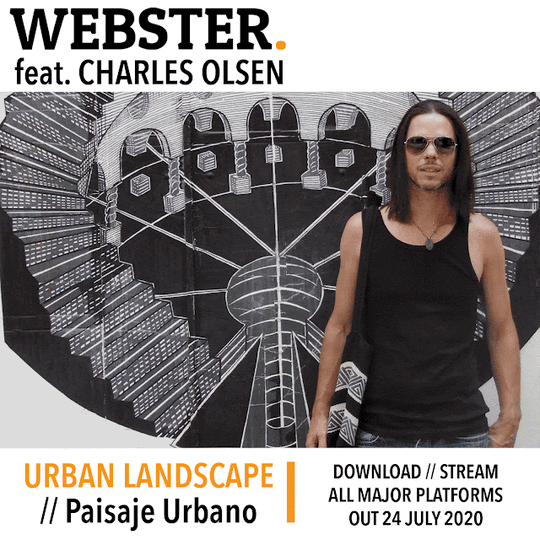
This is one of the cinemagraph images I prepared for the promotion of the single Urban Landscape/Paisaje Urbano (feat. Charles Olsen) which was released on 24 July 2020 as part of the Webster Collective. You can find a version with the music on my Instagram.
The single is available here: Urban Landscape/Paisaje Urbano (feat. Charles Olsen) – single, Webster Collective
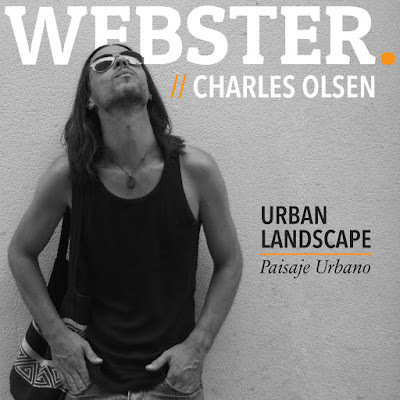
Cover art. Webster. Urban Landscape/Paisaje Urbano (feat. Charles Olsen)
November 3, 2021
Noho Mai in VII Festival Cinemística
Nuestro videopoema colaborativa en lengua maorí, Noho Mai, es seleccionado para el VII Festival Cinemística – Alrededores del silencio – en Granada, del 4 al 27 de noviembre 2021. La programación completa del festival se puede encontrar en blog.cinemistica.com.
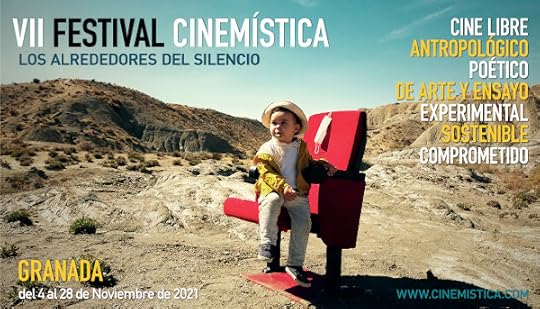
Y aquí están los detalles de la presentación de Noho Mai:
MIÉRCOLES 10 NOVIEMBRE 19:30H FACULTAD DE BELLAS ARTES
ESCULPIENDO EL SILENCIO
POSTALES DEL BALCÓN (Postcards from the balcony). Viky Polls. España 2020. 2min. Anim. Sin diálogos.
SCOTLAND (Escocia) Helena Pellicer. España 2020. 10:38. Exper. V.O. S.E.
KOSKETUS – SENSE OF TOUCH IN FINISH LANGUAGE (Kosketus, sentido del tacto en lengua finlandesa) Juan Castrillón, Vilja Hapaala. Finlandia 2020. 5:33 min. Doc. Sin diálogos.
HAIKU (Haiku) Martin Gerigk. Alemania 2020. 17:17 min. Exper. V.O. Japonés Subt. Inglés.
CREATURES OF THE WIND (Criaturas del viento) Josue A. Martínez. Indonesia 2019. 8:17 min. Ficción. Sin diálogos.
OCURRENCES OF QUESTIONABLE SIGNIFICANCE (Ocurrencias de significado dudoso) Dave Lojek. Alemania 2020. 9:00 min. Ficción. Sin diálogos.
MURIA (Heap) Ismael Aveleira. España 2020. 4 min. Sin diálogos.
NOHO MAI (Siéntate aquí) Peta Maria Tunui, Charles Olsen. España / Nueva Zelanda 2020. 5:33 min. Exper. V.O.S.E.
Invitados al coloquio: Víctor Borrego (Bellas Artes)
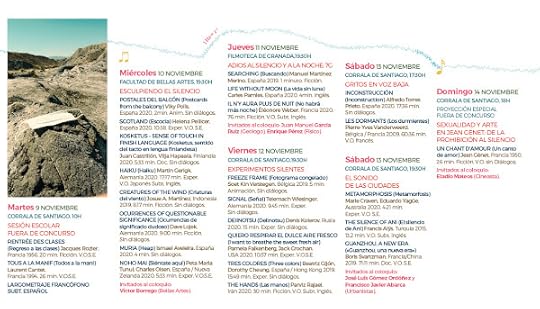
November 1, 2021
Libro de huellas
(2014) Libro de Huellas (‘Book of Traces’), Guinda, Ángel (poet), 3:16 min, Spain: antenablue.
Selected for Berlin: ZEBRA Poetry Film Festival, Argentina: VideoBardo Festival de Videopoesía
Featured in Poetry Film Live and Moving Poems, where you can read more about this poetry film.
Click CC for subtitles in English.
Directed by Charles Olsen.
Produced by antenablue.

October 30, 2021
hand-made mask
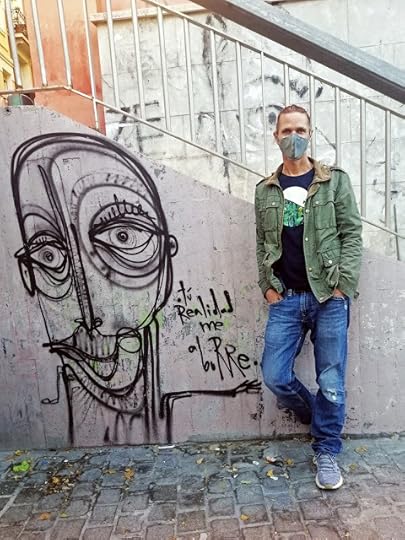
Looks stylish, feels comfortable, has unique design touches, saves money and waste, lasts for ages.
I made my first mask from some fabric Lilián had been given from Folklores, an African textile and clothes shop in our neighbourhood, with a lining made of an old linen shirt. The shirt had already been through a transformation as the bottom hem was ripping and I'd cut short the sleeves to get the fabric to fix it. Two years later and that mask has fallen apart from so many washing-cycles so I decided to make a new one.
First, I tried to put a new lining in the old one, but it took ages to unpick the old lining as it is finely stitched twice around the edge, and then the new lining was a fraction too small and so the mask didn't sit properly… so I made a new one with the same design but different fabric and I didn't like how it turned out either… but at least it made me more careful making this one.
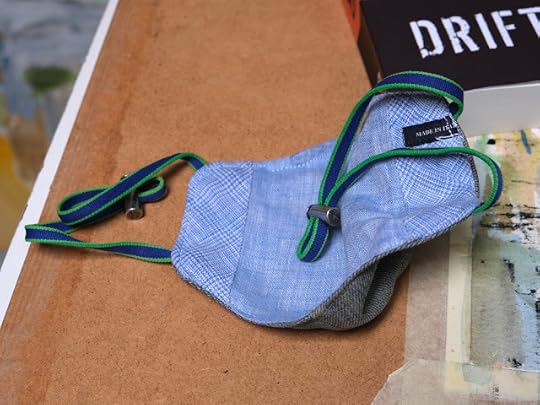
I used another mask I had as the model for the design, adjusting it slightly to fit my face better. The outside is from an old pair of jeans while the lining is the same linen shirt. I used the front of the shirt where the buttons were to get the nice edge detail including the 'Made in Italy' label (which helps to put it on the right way up!). The ear-loops are from a shoelace I'd saved from some old sneakers – as well as the colourful touch they are slightly stretchy so are comfy to wear – and I'd also saved the adjustable metal clips from something else and they work well to get keep the right tension.
I keep ties from product packaging and one bendy tie with a rubber coating was perfect to sew into the mask over the nose area so it can shape to the face (see photo below).
If you want to do your own the Freesewing website has some practical instructions to get you started and check out my post Simple Solutions for more ideas.
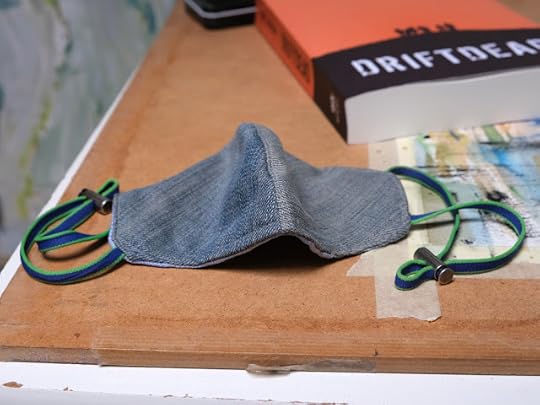
August 22, 2021
PoeMaRío – XIV Festival Internacional de Poesía en el Caribe, 2021
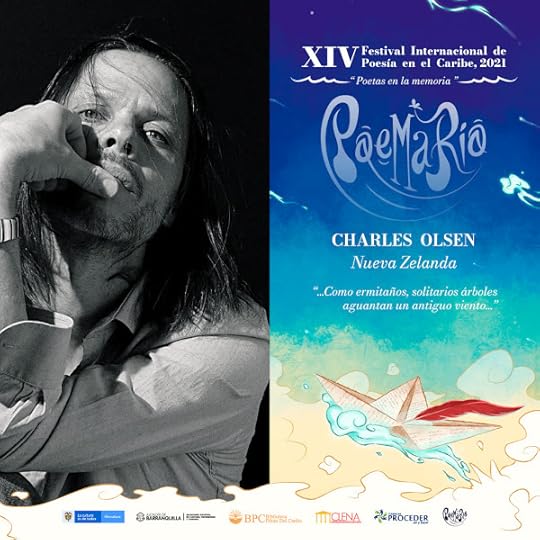
This week Lilian Pallares and I are looking forward to taking part in the XIV International Poetry Festival in the Caribbean, 'PoeMaRío', 24–29 August. I wish we could travel to be there in person, but this year it will be online instead…
I participate on the 24th August, alongside poets from Argentina and Colombia, at 10am (Colombia), 5pm (Spain).
You can see Lilián on Thursday 26th at 2pm (Colombia), 9pm (Spain), with poets from Ecuador, Colombia and Portugal.
And on Saturday 28th, Lilián and I will both be in conversation with Miguel Iriarte about our poetry filmmaking in 'Poesía visual: una perspectiva desde antenablue', at 5pm (Colombia), midnight (Spain).
You can see the festival live on the Biblioteca Piloto del Caribe Facebook page. You can also find the full programme online: bibliotecapilotodelcaribe.com
May 1, 2021
An internet presence - A waste of time?
This is an article I wrote to share on the artists' community blog 4art.com at the end of 2007. Back then I was connecting artists with the Myspace page Artistas de España, but this disappeared with Myspace. You can view an archived page of Artistas de España in The Internet Archive WayBack Machine and shortly after this article I set up the Myspace Aotearoa Artists (Archived page). It is worth reading through the comments on 4art.com to my original post which pointed to different ways artists used the internet with better or worse results.
An internet presence - A waste of time?
Posted by Charles Olsen on December 9, 2007 at 0:12 in Discussions
I'm loosing count of the number of profiles I've set up on the internet in the past year... maybe about 14... Artfind.co.nz, CreativeNZ, Fuel4arts, Dripbook, Virb, Facebook, Artelista, Issuu, WOW, IntrusiveArt, AniOman, Saatchi... That's not including the multiple profiles on Myspace. Is it a good thing I'm doing to promote my paintings? Or is it just one big bout of procrastination when I would be better off unplugging the computer and focussing on the paint, the canvas, the brushes? At least it becomes easier each time as I have images ready-prepared...
I've never sold a painting through the internet (tempting fate there) but occassionally I've met people who knew my work from seeing it online. It is a form of publicity which is out there for anyone to stumble across and you never know when chance will strike. But maybe I'm not using the internet in the best way? Or maybe the digital image is not the best way to show paintings?
Where are all the artists on the internet? I remember asking myself that when I first opened a Myspace page just over a year ago. It seemed it was all about bands and scoring dates and when I came across another artist it was like an exciting discovery. There were other sites which you had to pay for and they were full of artists chasing the dream of selling work but I was pretty skint and didn't want to fork out on a site that could probably live off the income from the artists and not worry too much about promoting me as an individual. So I jumped into the messy community of Myspace head first. I think it is because it is such a jumble of tacky images, glittery text, layout codes to make the techies ill... it's like a poor suburb with seedy backstreets, music blasting from every window, not a safe place to walk alone, you have your cheap flat and there is a great mixture of cultures, immigrants from the world over, you write with someone and she mentions a gallery you want to see and so you arrange to meet at the entrance to the underground station and she turns out to be someone different from the photo, even a different name, but she is involved with art... I think this is why it is attractive to artists. It's not about separating yourself from the rest - of being in a gallery or art magazine or website - but of being in there with everyone else. Everyone has a chance to show who they are and what they do and to share it with people who may never enter a gallery and the audience is potentially huge. It's not surprising that at least four of the finalists in the first Saatchi Showdown are active on Myspace.
An immigrant myself to Madrid, I guess that was in part the motivation to seek out other artists in Spain and I decided to create a webpage to gather artists together: Artistas de España. Luckily Spain has been slower than the UK in taking to Myspace so I was starting with something manageable. And now I have over 100 artists from all over the country and am starting to apply for funding for projects for everyone to get involved in and getting offers of help from the artists involved. Today I received a message from one of the artists, "Un hombre que viene de nueva zelanda se mueve más que cien españoles" (A man from New Zealand gets more done than a hundred Spanish!) I did it for free and have spent many hours on it and sometimes wonder if it is worth it all and that motivates me to make something of it. It's not unique - there are other artists collectives who have formed through myspace and there are individuals who have initiated participatory projects in their page. But there is a sense in which it is something untried, unstable, unchecked...
I like to think that the internet can be used as a creative tool, not just for promoting work but for initiating new work; for stimulating creativity. It's not just about showing what you do. The internet should be a place where you can feel at home, walk about in your underpants, pop down the pub with a friend and discuss the day to day things. We have to get away from marketing, and away from hoping to get noticed, and turn it into a tool for our own creativity.
So I guess well over half the sites I'm on have failed in this respect; in that they are just about having a presence and showing work. They are not about creativity. But we learn as we go along, no? I'd be interested in your reactions and ideas ;-)
Read the replies here: Discussion.
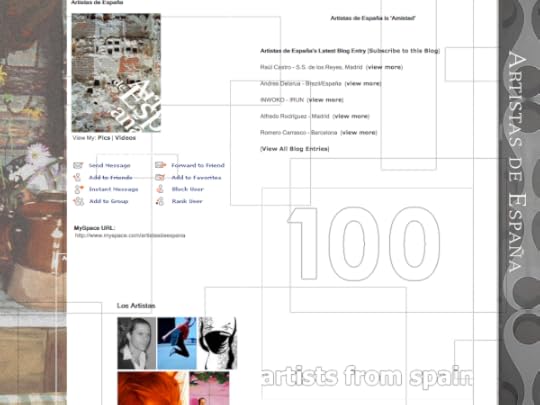 Screenshot from Myspace, Artistas de España
Screenshot from Myspace, Artistas de España
April 30, 2021
The Poetics of Poetry Film

I feel very lucky to have been invited to contribute to this book: 'The Poetics of Poetry Film' edited by Sarah Tremlett.
At the end of 2016 I began investigating the poetry films being made in Spain and Portugal and I interviewed filmmakers, and poets who were using video as part of their exploration. The book includes interviews I did with Alexandre Braga, Manuel Vilarinho, Eduardo Yagüe, Tarha Erena Sarmiento, Alejandro Céspedes, Celia Parra Díaz, Jordan T. Caylor, Belen Gache, Santiago Parres, Lola López-Cózar, Agustín Fernández Mallo, David Argüelles, Sándor M. Salas, and Angel Guinda.
I also wrote the essay 'Poetic Sound' where I speak of the poetry films I've made together with Lilian Pallares and the music for them composed by Odette Beris, Pablo Rubén Maldonado, and Pieter Nooten.
'The Poetics of Poetry Film' is available in paperback and digital formats from Intellect Books: intellectbooks.com/the-poetics-of-poetry-film
Me siento muy agradecido por la oportunidad de participar en este libro en inglés: 'The Poetics of Poetry Film' (La poética de la videopoesía) editado por Sarah Tremlett.
Fue a finales de 2016 cuando empecé a investigar la videopoesía que se estaba realizando en España y Portugal, y a entrevistar a los realizadores y poetas que utilizaban el vídeo como manera de explorar la poética. El libro incluye las entrevistas que hice a Alexandre Braga, Manuel Vilarinho, Eduardo Yagüe, Tarha Erena Sarmiento, Alejandro Céspedes, Celia Parra Díaz, Jordan T. Caylor, Belen Gache, Santiago Parres, Lola López-Cózar, Agustín Fernández Mallo, David Argüelles, Sándor M. Salas, y Angel Guinda.
Además he escrito el ensayo 'Poetic Sound' (Sonido poético) donde hablo de los trabajos que he hecho con Lilian Pallares y los videopoemas que hemos realizado con las composiciones de Odette Beris, Pablo Rubén Maldonado, y Pieter Nooten.
Se puede adquirer el libro (físico y digital) desde Intellect Books: intellectbooks.com/the-poetics-of-poetry-film
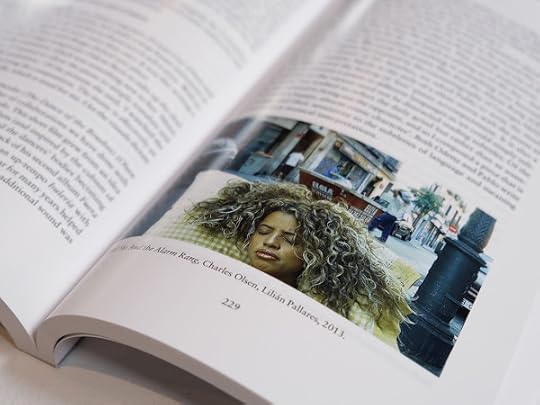
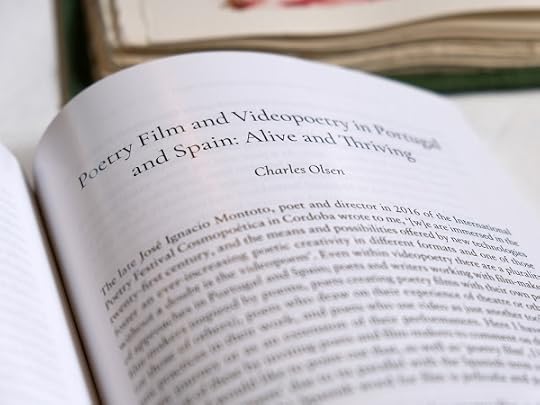
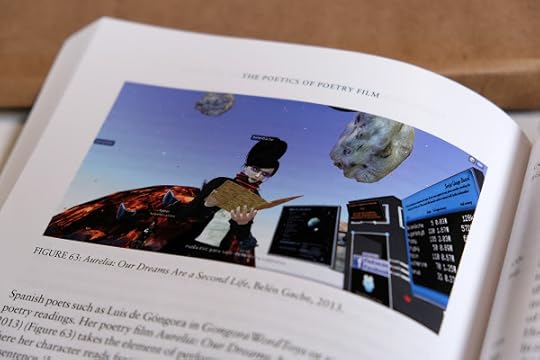
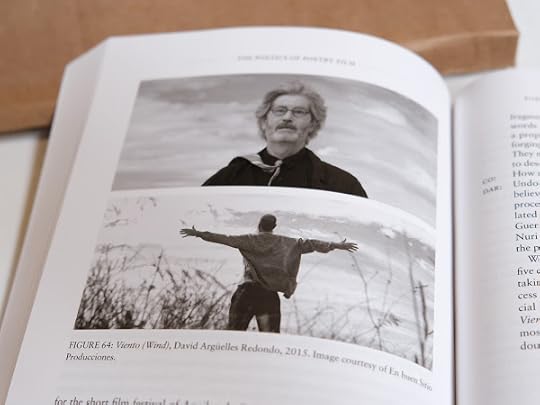
January 11, 2021
Freezing and baking
I've found it hard to concentrate what with everything that's been going on recently and also the cold in our north-facing attic flat that doesn't let you stay still for long, even with the central heating on all day. Today we noticed damp patches on the ceiling where the snow has begun seeping through the roof. At least we've managed to clear the Velux windows before the snow turns to ice and we aren't sitting in darkness any more. So I was very happy to head out with the camera on Saturday to capture the city covered in around half a metre of snow and shake off some cobwebs.
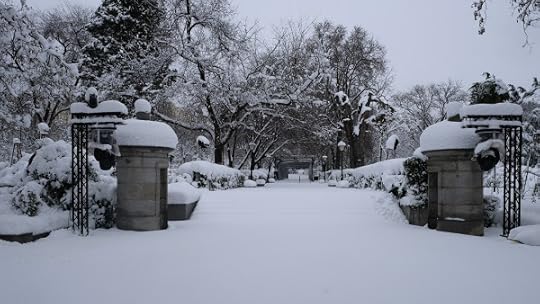 'Pristine' (Botanical Gardens, Madrid)
'Pristine' (Botanical Gardens, Madrid)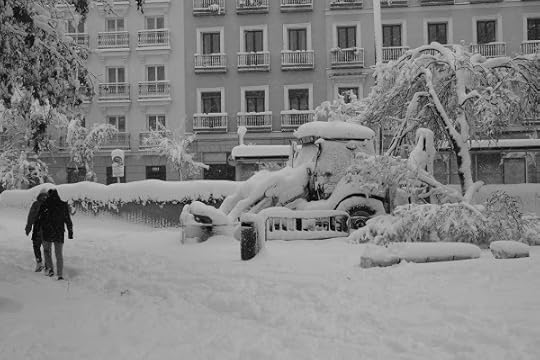 'Snowed in' (Tirso de Molina, Madrid)
'Snowed in' (Tirso de Molina, Madrid)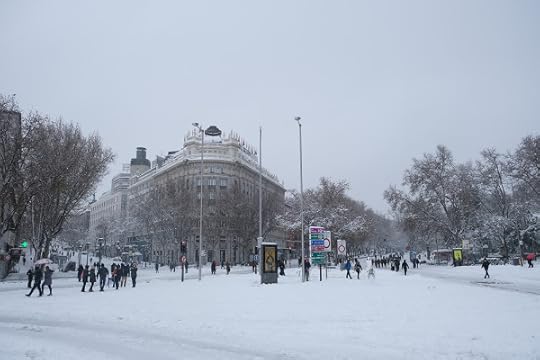 'An Alfred Sisley in Atocha' (Madrid)
'An Alfred Sisley in Atocha' (Madrid)I've seen snow a few times in Madrid but never like this. You can see a larger selection of my photos on my facebook album Salí a comprar pan ('I went out for some bread').
And for a complete contrast I invite you to see my summery photo 'Covid Glam' from the series Sea Air, published along with a commentary on Love in the Time of Covid – 'a chronicle of a pandemic'.
I was also invited to contribute two of my artworks to the December 2020 edition of Flash Frontier on the theme of 'Doors' which features short fiction from around the world.
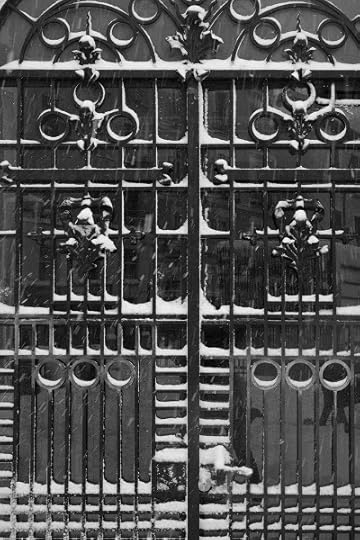 'Outlines' (Tirso de Molina, Madrid)
'Outlines' (Tirso de Molina, Madrid)January 2, 2021
Simple solutions – Soluciones sencillas
[ Saltar al español – Soluciones sencillas ]
I have always enjoyed challenges and finding simple answers to problems. Way back in 1983 I was in the Geological Museum in London for a Young Scientists Model Hot Air Balloon competition. Each balloon was given 30 seconds of hot air and let go. Many hardly got off the ground, others floated for a few seconds before coming back to earth. Mine was a very simple design and I'd carefully tested it with a hairdryer to make sure it was stable. One of the men running the competition saw my design and came over to tell me it would never fly. It came to my turn and after the statutory 30 seconds of hot air it began rising up and up and to everyone's surprise eventually hit the roof of the Atrium. If it hadn't hit one of the roof beams it might have stayed up even longer but it flipped over and as the hot air came out it formed a graceful parachute shape and gently glided back down, winning the junior section of the competition. Scientists are human too and don't always have the correct answers.
So I thought I'd share some simple ideas that may inspire you to try them out. Often with just a little love, care and creativity we can do things to improve our lives. Some of these ideas have come to me during this last year as we've had more time stuck at home. Here are my 'simple solutions'…
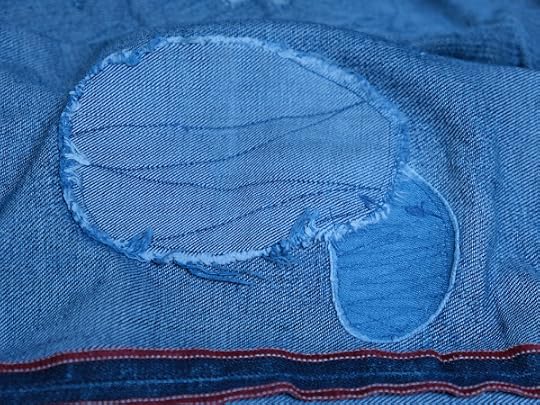
(All photos by me, Charles Olsen)
Patch it up
Perhaps the most obvious, but it's not often I find a really comfy pair of jeans and when I do I wear them week in week out, and I find it really hard to replace them. I bought myself a sewing machine in a sale which has made life much easier. You can either buy iron-on patches like the piece on the right, or just use another old pair of jeans and cut fabric to sew in place, like the larger patch above.
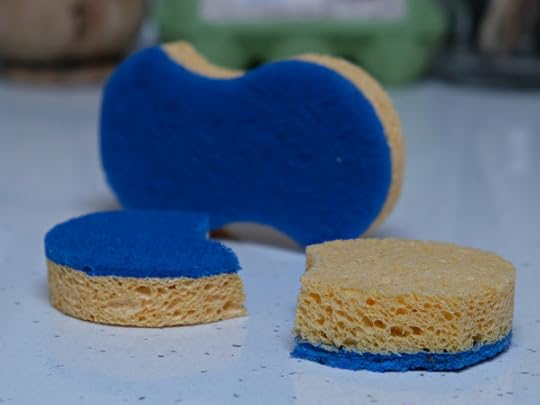 Make things last twice as long
Make things last twice as long I've taken to cutting things in half. Large bars of soap are one: as you don't wet the whole bar the soap lasts longer and it's more comfortable to hold on to. Sponges are another: each half lasts just as long as the whole sponge would. It's actually more comfortable to hold and easier to get into small spaces like inside cups for example. It may be strange at first but it totally makes sense once you've got used to it.
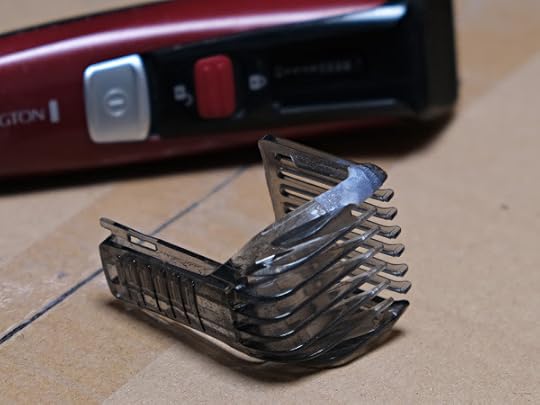 Don't accept built-in obsolescence
Don't accept built-in obsolescenceThe weak point on this Remington bread trimmer is the plastic guard and when it snapped I looked up replacement parts online… there aren't any. So as a guitarrist who has fixed many broken nails I tried the same technique on the plastic. It works fine and I haven't had any more problems.
You need: Cyanoacrylate (Superglue) and silk, or tissue. I used a guitarrist's nail kit which had a fibreglass cloth. Use a piece of paper or card to spread the glue – Never your fingers! Glue the join first. Cut silk to size to wrap around the break and both sides to add strength. Spread glue thinly around join and wrap silk around join. You just need enough glue to hold fabric in place. Once it is dry then add another layer of glue letting it soak into the silk. Leave to harden.
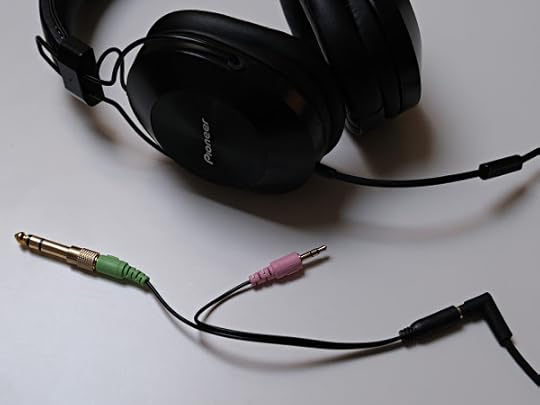 Find a work-around
Find a work-around I bought some new earphones not realising that nowadays as they are set up for mobile phones and include a microphone in the cable this meant they would only play in mono if attached to an old stereo device (like my piano keyboard for example). I went to one of the best audio shops in Madrid and they just suggested I buy new headphones… So after a lot of searching I tracked down this 3 euro cable that does the trick.
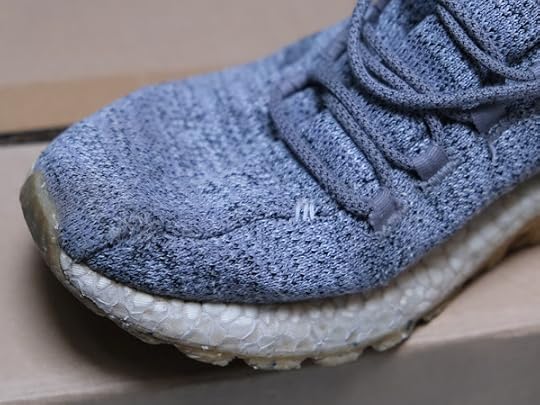 Keep on running
Keep on runningWhen I first bought these I loved the design. They are great for here in Spain where it doesn't rain that much. And I thought the way the fabric is folded and stitched over the toe area would reinforce this weak point. I also throw them in the washing machine every now and then and they come out looking almost new. Anyhow, eventually I got holes in both toes I could see my socks through.
You need: Cyanoacrylate (Superglue), a piece of fabric, needle and thread (match the colour). So I cut an oval of fabric a little bigger than the hole, put some Superglue on it and pressed it in place on the inside of the sneaker – Use a rubber glove to avoid sticking yourself to the inside of the sneaker. Once it has dried stitch closed the hole and stitch a little further out, making sure you go right through the fabric inside. With these mottled fabrics you will hardly notice the sewing and the sneakers will last for ages.
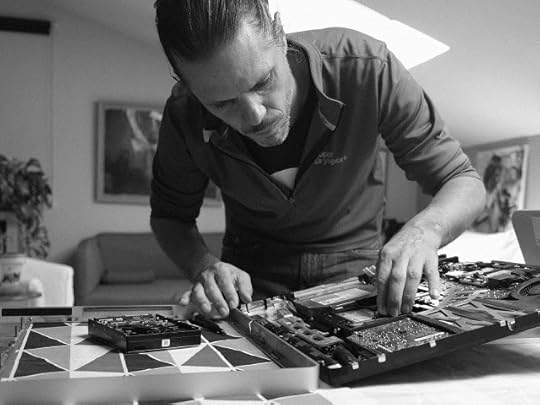
Try something new
I'm grateful for the Meccano I played with as a child. In September 2020 my computer's hard drive stopped working. I got it in late 2007 and it is a great machine so I looked online to see what I could do.
iFixit has kits and instructions for DIY upgrades – the kit I needed was only available from the US site so I looked up the pieces and bought them (cheaper) individually from Amazon in Spain and they arrived the next day (I clicked the wrong button and they added me to Amazon Prime again… but I cancelled my Prime subscription the same day so I didn't get charged at the end of the month.)
So I installed an SSD and it now starts up faster than when it was new. A friend recommended a gadget to plug the old drive into and I was able to recuperate almost all my old files.
Soluciones sencillas
Siempre he disfrutado de los retos y de encontrar respuestas sencillas a problemas aparentemente complicados. Hace años, en 1983, estuve en el Museo Geológico de Londres para un concurso de Globos de Aire Caliente de la asociación de jóvenes científicos. Cada globo recibió 30 segundos de aire caliente y luego los soltaron. Muchos no llegaron a subir y otros flotaban unos segundos antes de caer de nuevo tierra. Mi diseño fue muy sencillo y lo había probado con el aire del secador de pelo para asegurar su estabilidad. Uno de los hombres que organizaba el evento vio mi globo y se acercó para decirme que jamás volaría. Llegó mi turno y después de recibir la regulación de 30 segundos de aire caliente empezó a subir y subir, y para la sorpresa de todos llegó a tocar el techo del patio interior del museo. Si no hubiera chocado con una de las vigas del techo podría haber durado más tiempo, pero se volteó, expulsó el aire caliente y bajó lentamente de forma elegante como un paracaídas. Gané la sección juvenil del concurso. Los científicos también son humanos y no siempre tienen la verdad.
Entonces pensaba compartir unas ideas sencillas que te podrían inspirar. A menudo, con un poco de amor, cuidado y creatividad podemos hacer pequeños experimentos para mejorar nuestras vidas. Algunas de estas ideas me han venido este año mientras estaba confinado en casa. Aquí les comparto mis 'soluciones sencillas'…

(Fotos de Charles Olsen)
Remendar
Quizás es lo más obvio, pero pocas veces encuentro unos jeans muy cómodos. Luego me los pongo todo el tiempo y cuesta tirarlos. Compré una máquina de coser que facilita la vida, ya que puedes comprar parches que se aplican con plancha como la pieza que ven a la derecha, o cortar una pieza de otros viejos jeans y coserlo en su lugar como el parche grande de arriba.
 Que duran dos veces más
Que duran dos veces más He empezado a cortar las cosas por la mitad. Las pastillas de jabón grandes: ya que mojar toda la pastilla reduce rápidamente su tiempo de vida, y también es más fácil mantenerla en la mano. Las esponjas de lavar platos es otro de mis cometidos: cada mitad dura el mismo tiempo que una entera. Es realmente más cómodo para la mano y conveniente para espacios pequeños como las tasas por ejemplo. Al principio puede sentirse raro, pero una vez que te acostumbres tiene mucho sentido.
 No aceptes la obsolescencia programada
No aceptes la obsolescencia programadaEl punto débil de este barbero de Remington es el peine ajustable de plástico, y cuando se rompió busqué la pieza de repuesto pero no había… Bueno, siendo un guitarrista que ha arreglado muchas uñas rotas, utilicé la misma técnica en el plástico y no he tenido más problemas.
Necesitas Cyanoacrylate (pegamento), tela de seda o kleenex. Utilicé un kit de guitarrista con una tela de fibra de vidrio. Usa siempre un trocito de papel o cartón para extender el pegamento. ¡Nunca tus dedos! Ensamblar primero la parte rota con pegamento. Cortar un trocito de la tela para envolver la parte rota y reforzar por los lados. Aplicar pegamento en una capa muy fina y pegar la tela en posición. Una vez se seca añadir otra capa de pegamento para empapar la tela. Dejarlo a secar.
 Encontrar soluciones alternativas
Encontrar soluciones alternativasCompré unos audífonos nuevos, pero hoy en día siendo para los móviles –con un micro en el cable– significa que solo se escuchaba en mono desde el teclado del piano. Pregunté en una de las mejores tiendas de audio en la calle Barquillo pero querían venderme otros audífonos nuevos… Entonces, después de buscar por todos lados, encontré este cable por 3 euritos que funciona perfectamente.
 Sigue corriendo
Sigue corriendoMe encantó el diseño y vienen muy bien para España donde no llueve tanto. Me gustó como la tela está doblada sobre el dedo gordo y pensaba que iban a durar bastante. Las tiro en la lavadora de vez en cuando y salen casi como nuevas. Bueno, después de un par de años podría ver mis calcetines por los huecos del dedo gordo.
Necesitas: Cyanoacrylate (Pegamento), un trocito de cualquier tela, aguja e hilo (del mismo color). Cortar un parche de tela y pegarlo por dentro –usa un guante de goma para no pegarte al interior de la zapatilla–. Una vez seca puedes coser el hueco y asegurar que pasa bien la aguja por el parche interior. Con las telas moteadas de las zapatillas modernas casi no se nota el arreglo y te durarán un largo tiempo.
 Intentar algo nuevo
Intentar algo nuevoDoy gracias al Meccano con que jugaba de niño. En septiembre 2020 dejó de funcionar el disco duro de mi ordenador. Lo compré en 2007 y siendo una buena máquina busqué por internet para ver lo que podría hacer.
iFixit tiene kits e instrucciones para arreglos y actualizaciones – el kit que necesitaba estaba disponible solo en los Estados Unidos, así que encontré las piezas individuales (más baratas) de Amazon en España y llegaron al día siguiente (otra vez me metieron en el Amazon Prime sin querer… pero lo cancelé inmediatamente para evitar cargos al final del mes).
Entonces podría instalar un SSD (unidad de estado sólido) y mi ordenador arrancó más rápidamente que cuando era nuevo. Un amigo me recomendó una lector de disco duro para recuperar casi todos los archivos viejos.
November 26, 2020
Noho Mai flies to Cork
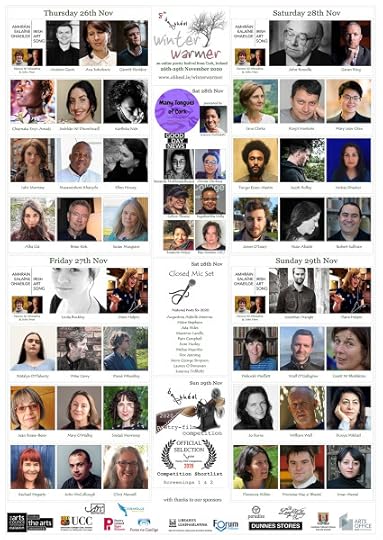
Our collaborative te reo Māori poetry film NOHO MAI — created as part of an online writing and film workshop run by New Zealanders, Charles Olsen and Peta-Maria Tunui, and the Colombian writer Lilián Pallares, during the Covid-19 confinement in Spain and Aotearoa, New Zealand — is one of 38 films chosen from 288 submissions received from 181 filmmakers in 49 countries for Ó Bhéal's 8th International Poetry-Film Competition. The shortlist represents 14 countries: Argentina, Australia, Belarus, Canada, England, Ireland, Isle of Man, Israel, Netherlands, New Zealand, Scotland, Sierra Leone, Spain & the USA.
Judges Dareina Ní Chinnéide and Paul Casey will select one winner to receive the Ó Bhéal award for best poetry-film, designed by glass artist Michael Ray. The winner will be announced directly after the screenings.
Sunday 29th November
2.00pm – 4.30pm
(Two Screenings: 2pm-3pm and 3.30pm-4.30pm)
"Ó Bhéal’s 8th Winter Warmer (and 1st online) festival presents 36 poets live from fifteen countries, over four days in November. The festival will feature two poetry workshops, four newly recorded Mini-Concerts from Tionscadal na nAmhrán Ealaíne Gaeilge (the Irish Language Art Song Project) devised by Dáirine Ní Mheadhra and John Hess, the shortlist screening and prize-giving for Ó Bhéal’s International Poetry-Film Competition, a Many Tongues of Cork session and a closed-mic set for new voices – poets who have featured regularly in Ó Bhéal’s online open-mic sessions during 2020."
Pensamientos lentos
- Charles Olsen's profile
- 8 followers



